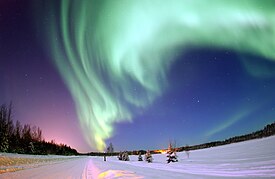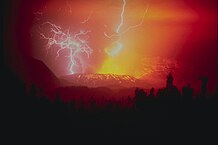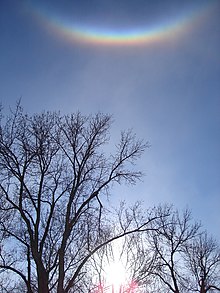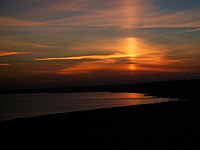
A natural phenomenon is an observable event which is not man-made. Examples include: sunrise, weather, fog, thunder, tornadoes; biological processes, decomposition, germination; physical processes, wave propagation, erosion; tidal flow, and natural disasters such as electromagnetic pulses, volcanic eruptions, hurricanes and earthquakes.
History
Over many intervals of time, natural phenomena have been observed by a series of countless events as a feature created by nature.
Physical phenomena
The act of:
Gallery
-
 Crystal in VCGS furnace
Crystal in VCGS furnace
-
 Liquid hydrogen bubble chamber photograph of an anti-proton colliding with a proton
Liquid hydrogen bubble chamber photograph of an anti-proton colliding with a proton
-
 Children notice an effect of static electricity
Children notice an effect of static electricity
Chemical phenomena
Biological phenomena
- Metabolism
- Catabolism
- Anabolism
- Decomposition – by which organic substances are broken down into a much simpler form of matter
- Fermentation – converts sugar to acids, gases and/or alcohol.
- Growth
- Birth
- Death
- Population decrease
Gallery
-
 Decomposition:a decaying peach over a period of six days. Each frame is approximately 12 hours apart, as the fruit shrivels and becomes covered with mold.
Decomposition:a decaying peach over a period of six days. Each frame is approximately 12 hours apart, as the fruit shrivels and becomes covered with mold.
Astronomical phenomena
Geological phenomena
See also: List of geological phenomena- Mineralogic phenomena
- Lithologic phenomena
- Rock types
- Igneous rock
- Igneous formation processes
- Sedimentary rock
- Sedimentary formation processes (sedimentation)
- Quicksand
- Metamorphic rock
- Igneous rock
- Rock types
- Endogenic phenomena
- Plate tectonics
- Phenomena associated with igneous activity
- Earth's magnetic field
- Exogenic phenomena
- Slope phenomena
- Weathering phenomena
- Glacial and peri-glacial phenomena
- Atmospheric phenomena
- Impact phenomena
- Coupled endogenic-exogenic phenomena
Gallery
-
 Geology: parabola-shaped lava flow illustrates Galileo's law of falling bodies, as well as blackbody radiation. The temperature can be discerned from the color of the blackbody.
Geology: parabola-shaped lava flow illustrates Galileo's law of falling bodies, as well as blackbody radiation. The temperature can be discerned from the color of the blackbody.
Meteorological phenomena
See also: Atmospheric phenomenon, Glossary of meteorology, and List of severe weather phenomenaViolent meteorological phenomena are called storms. Regular, cyclical phenomena include seasons and atmospheric circulation. climate change is often semi-regular.
-
 Lightning strikes during the eruption of the Galunggung volcano in 1982
Lightning strikes during the eruption of the Galunggung volcano in 1982
-
 A tornado on May 3, 1999 in central Oklahoma
A tornado on May 3, 1999 in central Oklahoma
Atmospheric optical phenomena
This section is an excerpt from List of atmospheric optical phenomena.


Atmospheric optical phenomena include:
- Afterglow
- Airglow
- Alexander's band, the dark region between the two bows of a double rainbow.
- Alpenglow
- Anthelion
- Anticrepuscular rays
- Aurora (northern and southern lights, aurora borealis and aurora australis)
- Belt of Venus
- Brocken Spectre
- Circumhorizontal arc
- Circumzenithal arc
- Cloud iridescence
- Crepuscular rays
- Earth's shadow
- Earthquake lights
- Glories
- Green flash
- Halos, of Sun or Moon, including sun dogs
- Haze
- Heiligenschein or halo effect, partly caused by the opposition effect
- Ice blink
- Light pillar
- Lightning
- Mirages (including Fata Morgana)
- Monochrome Rainbow
- Moon dog
- Moonbow
- Nacreous cloud/Polar stratospheric cloud
- Rainbow
- Sprite (lightning)
- Subsun
- Sun dog
- Tangent arc
- Tyndall effect
- Upper-atmospheric lightning, including red sprites, Blue jets, and ELVES
- Water sky
 A double rainbow at Minsi Lake, Pennsylvania
A double rainbow at Minsi Lake, Pennsylvania A sun pillar in Finistère, BrittanyAtmospheric optical phenomenon
A sun pillar in Finistère, BrittanyAtmospheric optical phenomenon
Oceanographic
- Oceanographic phenomena include tsunamis, ocean currents and breaking waves.
Gallery
-
 Tsunami by Hokusai 19th century
Tsunami by Hokusai 19th century
-
 Source: "Physiography for High Schools" by Albert L. Arey, Frank L. Bryant, William W. Clendenin, and William T. Morrey. 1911, USA.
Source: "Physiography for High Schools" by Albert L. Arey, Frank L. Bryant, William W. Clendenin, and William T. Morrey. 1911, USA.
-
 Shoreline wave-breaking (surf); Human riding surfboard.
Shoreline wave-breaking (surf); Human riding surfboard.
See also
- Act of God
- Electrical phenomena
- Materialism
- Midnight Sun
- Black Holes
- Natural Environment
- Nature
- Transient lunar phenomenon
References
- Missy Allen; Michel Peissel (1993). Dangerous Natural Phenomena. Chelsea House. ISBN 079101794X.
- William R. Corliss (1977). Handbook of unusual natural phenomena. Sourcebook Project. ISBN 0915554011.
- "Belt of Venus over Cerro Paranal". Picture of the Week. ESO. Retrieved 14 August 2013.
